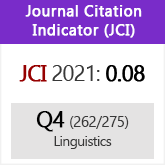Individual variability in cue weighting for first-language vowels
DOI:
https://doi.org/10.3989/loquens.2017.044Keywords:
individual differences, cue weighting, perception, Azerbaijani vowelsAbstract
This study investigates the use of different cues in discrimination of Azerbaijani /oe/ and /ɯ/ vowels. Regarding the large overlap in f1-f2 vowel space in the production of these vowels, this study researched for other possible cues in their categorization. Twenty native Azerbaijani listeners were tested through a perceptual identification test. Since f2 was weighted more consistently through the experiment, it is suggested that f2 is the primary cue in discriminating of this vowel pair. We observed individual differences in the perceptual weighting of f2 and f3 among the listeners. Although most of the participants gave more weight to f2, some others weighted f3 heavier than f2 or gave weight to both cues equally. These findings expand the knowledge on perceptual cue weighting and point the importance of examining cue weighting at the individual level.
Downloads
References
Abramson, A. S., & Lisker, L. (1985). Relative power of cues: F0 shift versus voice timing. In V. Fromkin (Ed.), Phonetic linguistics: Essays in honor of Peter Ladefoged (pp. 25–33). New York: Academic.
Adank, P., Smits, R., & Van Hout, R. (2004). A comparison of vowel normalization procedures for language variation research. The Journal of the Acoustical Society of America, 116(5), 3099–3107. https://doi.org/10.1121/1.1795335 PMid:15603155
Ainsworth, W. A. (1972). Duration as a cue in the recognition of synthetic vowels. The Journal of the Acoustical Society of America, 51, 648–651. https://doi.org/10.1121/1.1912889
Allen, J. S., Miller, J. L., & DeSteno, D. (2003). Individual talker differences in voice-onset-time. The Journal of the Acoustical Society of America, 113, 544–552. https://doi.org/10.1121/1.1528172
Bennett, D. (1968). Spectral form and duration as cues in the recognition of English and German vowels. Language and Speech, 11(2), 65–85. https://doi.org/10.1177/002383096801100201 PMid:5672019
Bladon, R. A. W., & Lindblom, B. (1981). Modeling the judgment of vowel quality differences. The Journal of the Acoustical Society of America, 69, 1414–1422. https://doi.org/10.1121/1.385824
Chistovich, L. A., & Lublinskaya, V. V. (1979). The 'center of gravity' effect in vowel spectra and critical distance between the formants: Psychoacoustical study of the perception of vowel-like stimuli. Hearing Research, 1(3), 185–195. https://doi.org/10.1016/0378-5955(79)90012-1
Chládková, K., Hamann, S., Williams, D., & Hellmuth, S. (2016). F2 slope as a perceptual cue for the front–back contrast in Standard Southern British English. Language and Speech, 60(3), 377–398. https://doi.org/10.1177/0023830916650991 PMid:28915781
Crystal, D. (2010). The Cambridge encyclopedia of language (3rd ed.). Cambridge and New York: Cambridge University Press.
Delattre, P., Liberman, A. M., Cooper, F. S., & Gerstman, L. J. (1952). An experimental study of the acoustic determinants of vowel color; Observations on one-and two-formant vowels synthesized from spectrographic patterns. Word, 8(3), 195–210. https://doi.org/10.1080/00437956.1952.11659431
Escudero, P., Benders, T., & Lipski, S. C. (2009). Native, non-native and L2 perceptual cue weighting for Dutch vowels: The case of Dutch, German, and Spanish listeners. Journal of Phonetics, 37(4), 452–465. https://doi.org/10.1016/j.wocn.2009.07.006
Fant, G. (1956). On the predictability of formant levels and spectrum envelopes from formant frequencies. In M. Halle (Ed.), For Roman Jakobson (pp. 109–120). The Hague: Mouton.
Fant, G. (1960). Acoustic theory of speech production. Mouton: The Hague.
Fant, G. (1973). Speech sounds and features. Cambridge: MIT Press. PMid:4125982
Fant, G., & Risberg, A. (1963). Auditory matching of vowels with two formant synthetic sounds. STL-Quarterly Progress Status Report, 4(4), 7–11.
Fox, R. A., Jacewicz, E., & Chang, CY. (2011). Auditory spectral integration in the perception of static vowels. Journal of Speech, Language, and Hearing Research, 54, 1667–1681. https://doi.org/10.1044/1092-4388(2011/09-0279)
Francis, A. L., Kaganovich, N., & Driscoll-Huber, C. (2008). Cuespecific effects of categorization training on the relative weighting of acoustic cues to consonant voicing in English. The Journal of the Acoustical Society of America, 124, 1234–1251. https://doi.org/10.1121/1.2945161 PMid:18681610 PMCid:PMC2680590
Fujimura, O. (1967). On the second spectral peak of front vowels: A perceptual study of the role of the second and third formants. Language and Speech, 10(83), 181–193. https://doi.org/10.1177/002383096701000304 PMid:5583884
Ghaffarvand Mokari, P., & Werner, S. (2016). An acoustic description of spectral and temporal characteristics of Azerbaijani vowels. Pozna? Studies in Contemporary Linguistics, 52(3), 503–518. https://doi.org/10.1515/psicl-2016-0019
Ghaffarvand Mokari, P., & Werner, S. (2017). Azerbaijani. Journal of the International Phonetic Association, 47(2), 207–212. https://doi.org/10.1017/S0025100317000184
Haggard, M., Ambler, S., & Callow, M. (1970). Pitch as a voicing cue. The Journal of the Acoustical Society of America, 47, 613–617. https://doi.org/10.1121/1.1911936
Hazan, V., & Rosen, S. (1991). Individual variability in the perception of cues to place contrasts in initial stops. Attention, Perception, & Psychophysics, 49(2), 187–200. https://doi.org/10.3758/BF03205038
Hillenbrand, J. M., Clark, M. J., & Houde, R. A. (2000). Some effects of duration on vowel recognition. The Journal of the Acoustical Society of America, 108, 3013–3022. https://doi.org/10.1121/1.1323463
Holt, L. L., & Lotto, A. J. (2006). Cue weighting in auditory categorization: Implications for first and second language acquisition. The Journal of the Acoustical Society of America, 119, 3059–3071. https://doi.org/10.1121/1.2188377
Idemaru, K., Holt, L. L., & Seltman, H. (2012). Individual differences in cue weights are stable across time: The case of Japanese stop lengths. The Journal of the Acoustical Society of America, 132, 3950–3964. https://doi.org/10.1121/1.4765076 PMid:23231125 PMCid:PMC3528741
Kapnoula, E. E. (2016). Individual differences in speech perception: sources, functions, and consequences of phoneme categorization gradiency (PhD thesis). University of Iowa.
Kiefte, M., & Kluender, K. R. (2008). Absorption of reliable spectral characteristics in auditory perception. The Journal of the Acoustical Society of America, 123, 366–376. https://doi.org/10.1121/1.2804951 PMid:18177166
Klatt, D. (1982). Prediction of perceived phonetic distance from critical-band spectra: A first step. ICASSP '82. IEEE International Conference on Acoustics, Speech, and Signal Processing, 1278–1281. https://doi.org/10.1109/ICASSP.1982.1171512
Kong, E. J., & Edwards, J. (2011). Individual differences in speech perception: Evidence from visual analogue scaling and eyetracking. Proceedings of the International Congress of Phonetic Sciences (ICPhS 17). Hong Kong, 17–21 August 2011 (pp. 1126–1129). PMid:21364592 PMCid:PMC3068488
Kong, E. J., & Edwards, J. (2016). Individual differences in categorical perception of speech: Cue weighting and executive function. Journal of Phonetics, 59, 40–57. https://doi.org/10.1016/j.wocn.2016.08.006 PMid:28503007 PMCid:PMC5423668
Morrison, G.S. (2007). Logistic regression modelling for first- and second-language perception data. In P. Prieto, J. Mascaró, & M.J. Solé (Eds.), Segmental and prosodic issues in Romance phonology (219–236). Amsterdam: John Benjamins.
Morrison, G. S. (2009). L1-Spanish speakers' acquisition of the English /i/-/?/ contrast II: Perception of vowel inherent spectral change1. Language and Speech, 52(4), 437–462. https://doi.org/10.1177/0023830909336583 PMid:20121041
Morrison, G. S. (2013). Theories of vowel inherent spectral change. In G. Morrison & P. Assmann (Eds.), Vowel inherent spectral change (pp. 31–47). Berlin–Heidelberg: Springer. https://doi.org/10.1007/978-3-642-14209-3
Nearey, T. M., & Kiefte, M. A. (2003). A neural network approach to the dimensionality of the perceptual vowel space. Canadian Acoustics, 31, 16–17.
Pols, L. C. W., van der Kamp, L J. Th., & Plomp, R. (1969). Perceptual and physical space of vowel sounds. The Journal of the Acoustical Society of America, 46, 458–467. https://doi.org/10.1121/1.1911711
Raizada, R. D. S., Tsao, F.M., Liu, H.M, & Kuhl, P. K. (2010). Quantifying the adequacy of neural representations for a cross-language phonetic discrimination task: Prediction of individual differences. Cerebral Cortex, 20(1), 1–12. https://doi.org/10.1093/cercor/bhp076 PMid:19386636 PMCid:PMC2860710
Rosner, B. S., & Pickering, J. B. (1994). Vowel perception and production. Oxford, UK: Oxford University Press. https://doi.org/10.1093/acprof:oso/9780198521389.001.0001
Shultz, A. A., Francis, A. L., & Llanos, F. (2012). Differential cue weighting in perception and production of consonant voicing. The Journal of the Acoustical Society of America, 132, EL95–EL101. https://doi.org/10.1121/1.4736711 PMid:22894322
Stevens, K. N. (1998). Acoustic phonetics. Massachusetts: MIT Press.
Stevens, K. N., & Klatt, D. H. (1974). Role of formant transitions in the voiced-voiceless distinction for stops. The Journal of the Acoustical Society of America, 55, 653–659. https://doi.org/10.1121/1.1914578
Strange, W., & Jenkins, J. J. (2013). Dynamic specification of coarticulated vowels. In G. Morrison & P. Assmann (Eds.), Vowel inherent spectral change (pp. 87–115). Berlin–Heidelberg: https://doi.org/10.1007/978-3-642-14209-3_5
Springer. https://doi.org/10.1007/978-3-642-14209-3_5 https://doi.org/10.1007/978-3-642-14209-3_5
Werker, J. F., & Logan, J. S. (1985). Cross-language evidence for three factors in speech perception. Attention, Perception, & Psychophysics, 37(1), 35–44. https://doi.org/10.3758/BF03207136
Published
How to Cite
Issue
Section
License
Copyright (c) 2018 Consejo Superior de Investigaciones Científicas (CSIC)

This work is licensed under a Creative Commons Attribution 4.0 International License.
© CSIC. Manuscripts published in both the printed and online versions of this Journal are the property of Consejo Superior de Investigaciones Científicas, and quoting this source is a requirement for any partial or full reproduction.All contents of this electronic edition, except where otherwise noted, are distributed under a “Creative Commons Attribution 4.0 International” (CC BY 4.0) License. You may read here the basic information and the legal text of the license. The indication of the CC BY 4.0 License must be expressly stated in this way when necessary.
Self-archiving in repositories, personal webpages or similar, of any version other than the published by the Editor, is not allowed.















